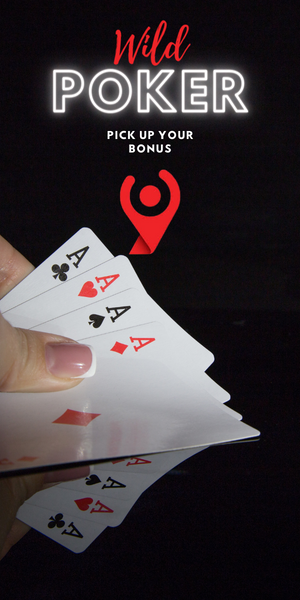How to play Poker
These are the most popular poker games.
- Texas Hold’em: Texas Hold’em is the most widely played form of poker. Each player is dealt two private cards and must use a combination of these cards and the community cards on the table to make the best five-card hand.
- Omaha: Omaha is similar to Texas Hold’em, but players are dealt four private cards instead of two. In Omaha, players must use exactly two of their private cards and three community cards to form their hand.
- Seven-Card Stud: Seven-Card Stud is an older variant of poker that was once the most popular form of the game. Players receive a combination of face-up and face-down cards over several betting rounds, aiming to make the best five-card hand.
- Five-Card Draw: Five-Card Draw is a classic and straightforward form of poker. Each player receives five private cards and has the opportunity to exchange some or all of their cards for new ones. The goal is to make the best five-card hand after the draw.
- Razz: Razz is a lowball variant of poker, where the goal is to make the lowest hand possible. The best hand in Razz is A-2-3-4-5 (the wheel), and straights and flushes do not count against the player’s hand.
- Omaha Hi-Lo: Omaha Hi-Lo, also known as Omaha Eight or Better, is a variant of Omaha where the pot is split between the best high hand and the best low hand. To qualify for the low hand, a player must have five unpaired cards with ranks of eight or lower.
- Caribbean Stud Poker: Caribbean Stud Poker is a casino game where players compete against the dealer rather than each other. Each player receives five cards, and the goal is to have a higher-ranking hand than the dealer’s.
- Pai Gow Poker: Pai Gow Poker is a casino game that combines elements of poker and traditional Chinese dominoes. Players receive seven cards and must divide them into two hands: a five-card hand (high hand) and a two-card hand (low hand). The goal is to beat both of the dealer’s hands.
How to play Texas Hold'em
Texas Hold’em is the most popular and widely played variant of poker. Here are the basic rules of Texas Hold’em:
- The game begins with each player being dealt two private cards, known as “hole cards” or “pocket cards.”
- The first round of betting starts with the player to the left of the dealer button. This position rotates clockwise after each hand.
- After the initial betting round, the dealer places three community cards face-up on the table. This is called the “flop.”
- A second round of betting takes place, starting with the player to the left of the dealer.
- Following the second betting round, the dealer reveals a fourth community card, called the “turn” or “fourth street.”
- Another round of betting occurs, with the same betting sequence as before.
- Finally, the dealer reveals the fifth and final community card, known as the “river” or “fifth street.”
- A final round of betting takes place, and if more than one player remains after the betting is complete, a showdown occurs.
- In the showdown, players use their two hole cards and the five community cards to create the best possible five-card hand. The player with the highest-ranking hand wins the pot.
- If there is a tie, the pot is divided equally among the players with the best hands.
- Throughout the game, players can choose to bet, raise, call, or fold, depending on the strength of their hand and their strategy. The betting rounds and community cards offer opportunities for players to assess the strength of their hands and make strategic decisions.
- Texas Hold’em requires a blend of skill, strategy, and psychological insight. The game is often played in various formats, including cash games and tournaments, with different betting structures such as no-limit, limit, or pot-limit.
How to play Omaha
- Omaha is a popular variant of poker that shares similarities with Texas Hold’em. Here’s a basic guide on how to play Omaha:
- Game Setup: Omaha is typically played with a standard 52-card deck. Each player is dealt four private cards, known as “hole cards,” that are only visible to them. Additionally, five community cards are placed face-up on the table.
- Betting Rounds: The game begins with the two players to the left of the dealer posting the small blind and big blind, respectively. Then, the dealer distributes the four hole cards to each player. The first round of betting begins with the player to the left of the big blind.
- The Flop: After the first betting round, the dealer reveals the first three community cards, called the “flop,” in the middle of the table. These cards are shared by all players and can be used in combination with their hole cards to form the best hand.
- Second Betting Round: Another round of betting follows the flop, starting with the player to the left of the dealer button.
- The Turn: Once the second betting round is complete, the dealer reveals the fourth community card, known as the “turn” or “fourth street.” This card is added to the three existing community cards on the table.
- Third Betting Round: A third round of betting commences, again beginning with the player to the left of the dealer button.
- The River: After the third betting round concludes, the dealer reveals the fifth and final community card, referred to as the “river” or “fifth street.” This card is placed next to the existing community cards.
- Final Betting Round: The final round of betting takes place, following the same betting sequence as before.
- Showdown: If there are two or more players remaining after the final betting round, a showdown occurs. Players must create their best hand using precisely two of their hole cards and three of the community cards. The player with the highest-ranking hand wins the pot.
- Pot Distribution: In Omaha, the pot may be split if two or more players have equally ranked hands. In such cases, the pot is divided equally among the winners.
- Remember that the betting structure in Omaha can vary, with options such as pot-limit Omaha (where the maximum bet is the current size of the pot) or limit Omaha (with predetermined bet sizes). It’s crucial to understand the specific rules and betting structure being used before playing Omaha.
How to play Seven-Card Stud
- Seven-Card Stud is a classic form of poker that predates Texas Hold’em and Omaha. Here’s a guide on how to play Seven-Card Stud:
- Game Setup: Seven-Card Stud is typically played with a standard 52-card deck. Each player is dealt two private cards (hole cards) and one face-up card (door card). The player with the lowest door card starts the betting with a forced bet called the “bring-in.”
- Third Street: Each player is dealt one more face-up card. The player with the highest-ranked exposed cards starts the betting. The betting round continues clockwise.
- Fourth Street: Each player is dealt another face-up card. The player with the highest-ranked exposed cards starts the betting again. From this point on, the betting rounds start with the player showing the highest-ranked exposed cards.
- Fifth Street: Each player is dealt another face-up card. The same betting pattern continues as in the previous rounds.
- Sixth Street: Each player is dealt a fifth face-up card. The betting follows the same pattern.
- Seventh Street (The River): Each player receives a final card, face-down (the hole card). The last betting round takes place, starting with the player showing the highest-ranked exposed cards.
- Showdown: If two or more players remain after the final betting round, a showdown occurs. Each player creates the best possible hand using any five of their seven cards (two hole cards and five community cards). The player with the highest-ranking hand wins the pot.
- Pot Distribution: If multiple players have equally ranked hands, the pot is divided equally among them.
- In Seven-Card Stud, there is no community card aspect like in Texas Hold’em or Omaha. Instead, each player receives their own individual set of cards. Paying attention to the exposed cards of opponents is crucial in making strategic decisions.
- It’s important to note that the rules and betting structures may vary in different variations of Seven-Card Stud, such as High-Low (split pot between the highest and lowest hands). Before playing, familiarize yourself with the specific rules and variations being used.
How to play Five-Card Draw
Five-Card Draw is a classic and straightforward form of poker. Here’s a step-by-step guide on how to play:
- Game Setup: Five-Card Draw is typically played with a standard 52-card deck. Each player antes or places a small forced bet to create a starting pot.
- Deal the Cards: Each player is dealt five private cards face-down.
- First Betting Round: The player to the left of the dealer starts the first betting round. They have the option to fold (discard their cards and leave the hand), call (match the current bet), or raise (increase the bet). Betting continues clockwise around the table.
- Draw Phase: After the first betting round concludes, there is an opportunity for players to improve their hand by discarding some or all of their cards. Starting with the player to the left of the dealer, each player may choose to discard (or “draw”) up to five cards from their hand and receive an equal number of replacement cards from the deck. Alternatively, they can choose to keep all their cards and “stand pat.”
- Second Betting Round: Once the draw phase is complete, a second round of betting takes place, starting with the player to the left of the dealer. The same options of folding, calling, or raising apply.
- Showdown: If more than one player remains after the second betting round, a showdown occurs. Players reveal their hands, starting with the last player who bet or raised. The player with the best five-card hand wins the pot.
- Pot Distribution: The player with the best hand takes the entire pot. If there is a tie, the pot is split equally among the tied players.
- Dealer Position: After each hand, the dealer button moves one position to the left, and the next hand begins.
- It’s important to note that Five-Card Draw is a game of skill and strategy, where players must assess the value of their hand and make decisions based on the likelihood of improving their hand through drawing and the actions of other players.
- Remember to familiarize yourself with the specific rules and variations being used, as some games may have additional rules or variations on betting structures.
How to play Razz
Razz is a variation of seven-card stud poker where the goal is to make the lowest possible five-card hand. Here’s a step-by-step guide on how to play Razz:
- Setup: Razz is typically played with two to eight players. Each player is dealt two private cards (hole cards) and one face-up card (door card). The player with the highest door card is required to bring-in (place a forced bet) to start the betting.
- Bring-In and Betting: The player with the highest-ranking door card is required to bring-in, which is usually a small bet. The betting then proceeds clockwise around the table, giving each player the option to fold, call the bring-in bet, or raise.
- Fourth Street: After the first round of betting, each player still in the hand is dealt another face-up card called “fourth street.” The player with the lowest-ranking hand showing (based on the face-up cards) starts the betting action. In the case of a tie, the suit of the fourth street card is used to determine who bets first.
- Fifth and Sixth Street: Two more face-up cards are dealt to each remaining player, with a round of betting following each card. The fifth street card is also known as “fifth street,” while the sixth street card is often referred to as “sixth street.”
- Seventh Street (River): Each player still in the hand receives a final face-down card called “seventh street” or the “river.” Another round of betting takes place, starting with the player showing the lowest-ranking hand based on their face-up cards.
- Showdown: If there are two or more players remaining after the betting on seventh street, a showdown occurs. The remaining players reveal their hole cards, and the player with the lowest five-card hand wins the pot. The lowest hand in Razz is A-2-3-4-5, also known as the “wheel” or “bicycle.”
- Ranking of Hands: In Razz, the ranking of hands is different from traditional poker. The best hand is the lowest hand, and straights and flushes do not count against you. Ace is always considered low, and pairs, three-of-a-kind, etc., do not affect the hand’s value. The lowest possible hand is A-2-3-4-5, and the highest possible hand is 6-5-4-3-2.
- Remember that Razz is a lowball game, so you want to aim for the lowest possible hand. It’s essential to pay attention to the door cards of your opponents and keep track of the cards that have been dealt to determine the likelihood of improving your hand.
We hope this guide helps you understand how to play Razz! Enjoy your game!
How to play Omaha Hi-Lo
Omaha Hi-Lo, also known as Omaha 8 or better, is a popular variation of poker. It is similar to Texas Hold’em but with a few key differences. The game is usually played with a standard deck of 52 cards and can accommodate 2 to 10 players.
The objective of Omaha Hi-Lo is to create the best possible hand using a combination of four hole cards, which are dealt face-down to each player, and five community cards, which are placed face-up on the table.One significant distinction in Omaha Hi-Lo is that the pot is split between the best high hand and the best low hand at the showdown. The high hand follows traditional hand rankings, while the low hand is determined by the lowest five-card combination with cards ranked 8 or lower. The best low hand is called the “nut low.” In order to qualify for the low hand, a player must have five unpaired cards ranked 8 or lower.
Here are some key rules and features of Omaha Hi-Lo:
- Each player is dealt four hole cards.
- Five community cards are dealt face-up on the table in three stages: the flop (three cards), the turn (one card), and the river (one card).Players must use exactly two of their hole cards and three community cards to form their hand.At the showdown, the pot is divided between the best high hand and the best low hand, if it qualifies.
- However, one player can win both the high and low sides of the pot, which is called “scooping.”When evaluating the low hand, the ace can be used as either a high card or a low card. Therefore, the best possible low hand is A-2-3-4-5, also known as the “wheel.”To qualify for the low hand, a player must have five unpaired cards ranked 8 or lower.
- If there is no qualifying low hand, the high hand takes the entire pot.Betting in Omaha Hi-Lo typically involves blinds (forced bets) and subsequent rounds of betting, including a pre-flop, flop, turn, and river.
- The betting structure can vary, such as fixed limit, pot limit, or no limit.
Omaha Hi-Lo requires careful consideration of both the high and low potential of your hand. It’s important to analyze the board and your opponents’ actions to make strategic decisions and maximize your chances of winning either or both sides of the pot.
How to play Caribbean Stud Poker
Caribbean Stud Poker is a popular casino card game that is derived from traditional five-card stud poker. It is played against the dealer rather than other players. The objective of the game is to have a higher-ranked poker hand than the dealer’s hand.
Here’s how Caribbean Stud Poker is typically played:
Each player places an initial bet, known as the “ante,” on the designated spot on the table.
The dealer deals five cards face-down to each player, including themselves. The dealer’s last card is dealt face-up.
After looking at their cards, players can choose to either fold or continue playing. If they fold, they forfeit their ante bet. If they decide to play, they must make an additional bet, known as the “call,” which is usually twice the amount of the ante.
Once all players have made their decisions, the dealer reveals their remaining four cards.
The dealer must have a hand that qualifies to play. This means the dealer must have at least an Ace-King or higher-ranked hand. If the dealer’s hand does not qualify, the players who are still in the game receive even money on their ante bet, and the call bet is returned as a push.
If the dealer’s hand qualifies, the player’s hands are compared to the dealer’s hand. If the player has a higher-ranked hand, they win even money on both the ante and call bets. If the dealer’s hand is higher-ranked, the player loses both bets.
In the event of a tie, both the ante and call bets are returned as a push.
Some variations of Caribbean Stud Poker also offer a progressive jackpot side bet, where players can win additional payouts based on the strength of their hand, regardless of the dealer’s hand.
It’s important to note that in Caribbean Stud Poker, players are not allowed to communicate or exchange information with each other. Each player is solely playing against the dealer, making it a game of individual hands rather than a competition against other players.
Caribbean Stud Poker offers a simpler and more relaxed alternative to traditional poker games, with the added excitement of potential large payouts through the progressive jackpot side bet.
How to play Pai Gow Poker
Pai Gow Poker is a popular casino card game that is based on the Chinese domino game called Pai Gow. However, Pai Gow Poker is played with a standard deck of 52 cards, plus one Joker. The game is played against the dealer, and the objective is to create two separate poker hands one high hand and one low hand that are both stronger than the dealer’s corresponding hands.
Here’s a step-by-step overview of how Pai Gow Poker is typically played:
- Each player places a bet on the table.
- The dealer shuffles the cards and deals seven cards face-down to each player, including themselves.
- The players must arrange their seven cards into a five-card high hand and a two-card low hand.
- The high hand must be stronger than the low hand.
- The Joker can be used to complete a straight, flush, straight flush, or act as an Ace.
- Once the players have set their hands, they place their two hands face-down on the table.
- The dealer reveals their own cards and sets their hand according to specific rules known as the “house way.”
- The dealer must follow a predetermined set of rules for setting their hand.
- The player’s high and low hands are compared to the dealer’s corresponding hands.
- If both the player’s hands are stronger than the dealer’s, the player wins.
- If only one hand is stronger, it’s a push. If both hands are weaker, the player loses.
- If the player and the dealer have the same value in one hand and the other hand is a tie, it’s considered a push, and the player neither wins nor loses.
- In the event of a tie in both hands, the dealer wins.
Pai Gow Poker offers a slower-paced and strategic gaming experience compared to other casino card games. It requires players to think strategically about how to divide their cards into two strong hands while considering the dealer’s potential hand strength.




